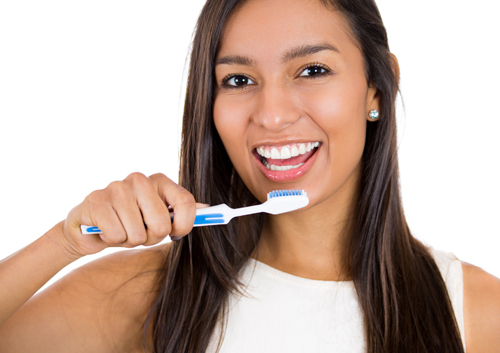December 1st, 2021

Inflamed gums are a fairly common dental issue, but unfortunately, many people don't take the problem seriously enough. If you ignore inflamed gums and continue your usual routine, you could be encouraging a much more severe inflammation problem, and the pain that goes along with that. Fortunately, it is quite easy to relieve inflamed gums if you use the tips below.
Use Soft Bristles
A soft-bristle toothbrush - the softest you can buy - is a must for anyone with inflamed gums. Anything that makes contact with your gums can cause you pain, so fine and soft bristles are always the best choice.
Use Sensitive Formula Toothpaste
The toothpaste marketed as “Sensitive Teeth Formula” contain special ingredients to help relieve sensitivity. When your gums are inflamed, even light brushing can cause some pain. Using a special toothpaste will help reduce that pain and make it easier to brush your teeth effectively. The effect becomes stronger as you use the toothpaste more, so use it for each brushing.
Visit Our Office
If your gums remain swollen for more than a few days or a week, set up an appointment with Drs. Tom Holmes, Gordon Lansdown, Karen Nesbitt, Nick Cosman, Brett Empringham, and Patrick McDonough. There is a long list of conditions that could be causing your swollen gums, everything from gum disease to pregnancy, so you need to find out where your issue is coming from. Most of the time, Drs. Tom Holmes, Gordon Lansdown, Karen Nesbitt, Nick Cosman, Brett Empringham, and Patrick McDonough can easily treat the swollen gum issue at our Kingston, ON office, or can give you an effective treatment to take home.
November 24th, 2021

There are numerous options for dental treatments out there, so how do you choose which are right for you? Our experts at Cataraqui Dental Centre have handpicked the three must-have procedures that we believe can benefit nearly every patient.
- Periodontal Exam: This should happen at least once a year and is quick and painless. Drs. Tom Holmes, Gordon Lansdown, Karen Nesbitt, Nick Cosman, Brett Empringham, and Patrick McDonough or your hygienist will carefully probe around each tooth and take measurements that indicate the health of the bone and its supporting tissue. This appointment is worthwhile because of the known fact that gum disease can increase the risk of potentially fatal conditions such as heart disease and stroke. Silent killers like diabetes can show signs in the mouth before the person becomes aware of other symptoms. Did you know adults lose more teeth to periodontal disease than to cavities? A simple screening once a year could save your smile and boost your overall health!
- Dental Sealant: For both adults and children, sealants provide a protective barrier from bacteria deep in the pits and grooves of the teeth where cavities often start. Sealants placed in childhood will often wear away in adulthood, so replacing them is useful because it can help prevent tooth decay later on. Dental insurance will likely not cover sealants for adults, but the cost of a sealant for prevention versus the cost of a filling is much lower, and definitely worth it.
- In-office Whitening: Most people develop tooth stains. in-office whitening at our Kingston, ON office is the perfect way to correct discoloration. It’s safe and produces dramatic results in a short amount of time. In two hours, you could take years off your age. Who wouldn’t want that?
November 17th, 2021

A shopping mall is a great place to get lots of errands done in one trip. Department stores, clothing boutiques, specialty shops? So many tempting options all in one place. But teeth whitening? Maybe not.
Dental office whitening provides you with the whitest possible teeth in the safest possible manner. Your teeth will be checked first for any conditions that might make whitening a bad idea, such as tooth decay, weakened enamel, or gum disease. Drs. Tom Holmes, Gordon Lansdown, Karen Nesbitt, Nick Cosman, Brett Empringham, and Patrick McDonough will make sure your gums and mouth are protected. A gel with a higher concentration of bleaching agents than those available over-the-counter will be applied, and your whitening progress will be monitored. You can also ask about having a custom-fitted tray made for at use at home with professional whitening gel.
What is different about mall bleaching?
- No dental exam will be provided beforehand. If you have dental issues, the whitening process might cause further problems such as tooth sensitivity or gum inflammation.
- The amount of peroxide in the bleaching agents can vary from place to place. You might end up with something equivalent to home whitening strips, or you might be exposed to solutions that should only be available in a dentist’s office.
- Finally, in many areas, mall whitening is actually illegal because it is considered the practice of dentistry without a license. Mall kiosks skirt this problem by having customers insert the trays full of gel themselves—a practice that does not take the place of professional training, licensing, and regulation.
A mall kiosk is a convenient place to select a new phone. Or try an unusual hair care product. Or purchase the latest in fad toys. But when it comes to your dental health, it’s worth a special trip to our Kingston, ON office if you want the safest, most effective whitening.
November 10th, 2021

With so many toothpastes available in so many price ranges, it can be difficult to be sure you are selecting the right one for your needs. You need a product that not only protects against tooth decay, but also addresses any special concerns that Drs. Tom Holmes, Gordon Lansdown, Karen Nesbitt, Nick Cosman, Brett Empringham, and Patrick McDonough and our team have raised. Look for the Canadian Dental Association seal and do some research to find the toothpaste that best meets your needs.
Choose a Product Approved by the Canadian Dental Association
The Canadian Dental Association approves dental products such as toothbrushes, dentures, mouthwashes, dental floss, and toothpastes when they meet certain quality standards. Before products can display the seal, the Canadian Dental Association must verify that the product does what it claims to do. Look for the Canadian Dental Association seal on the toothpaste package before you buy it. Also, check to make sure that the toothpaste contains fluoride, which helps protect against decay.
Consider Special Needs
You may be depending on your toothpaste to perform extra tasks beyond cleaning your teeth. These are some common concerns that the right toothpaste can address.
- Bad breath (halitosis)
- Sensitive teeth
- Plaque or gingivitis
- Tartar
- Yellowing teeth
The Canadian Dental Association’s website has a tool that lets users input their requirements and view a list of the toothpastes that carry the Canadian Dental Association’s seal and address those particular oral health needs.
Make Your Children’s Tooth-Brushing Experience Fun
If you select toothpaste that contains fluoride and has the Canadian Dental Association seal, most types of toothpaste will be fine for your children as long as they have no special needs. Allowing your kids to select fun toothpaste can encourage them to enjoy the brushing experience more, so that they brush more frequently and do a better job.
The following toothpaste characteristics can make brushing more fun for children.
- Fun flavors, such as bubble gum, berry, and watermelon
- Sparkles and swirls that make the toothpaste appear more attractive
- Toothpaste that comes in a pump
- Toothpaste with a container decorated with superheroes






